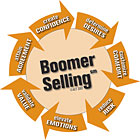
How do we justify buying this 3,000-pound, chrome-encrusted, energy-inhaling monster? Easy: better gas mileage.
We need to validate value. The more value you validate, the more we’ll buy from you. It’s just that simple. The seven elements of often-overlooked value are:
1. People
2.Process
3.Product
4.Protection
5.Profit
6.Proposal
7.Price
• People:The most important thing Boomers shop for is people we can trust. Boomers not only “buy” the person selling the product, we must also be comfortable with everyone who comes into our homes to do the work. We want to know, does your firm run criminal background checks or run a work-release program? Are your employee drug tests graded on a curve? Mention your team’s qualifications, training, skills, and attitudes. Bottom line: Tell us why you’re safe to hire.
• Process:“94 percent of all failure is caused by process, not people.”
- Dr. W. Edwards Deming
Boomers with money made it by sticking to a process, so tell us about yours. Show that you’ve thought out the entire project. Tell us how the job will be organized. Answer likely questions before they arise: what time you will start, how long it will take, how quality will be controlled. In the unlikely event we have trouble, who do we call and what can we expect?
• Product:Problems are not solved by equipment alone. We will never feel good buying from anyone if we think we can get the same thing for less money somewhere else, so tell why it’s impossible for others to offer the same thing you do. We need to know your product isn’t just the equipment; it’s the sum total of dozens of wires, pipes, parts and pieces external of the equipment.
Show how peak efficiency and reliability are impossible without proper design and installation. Explain that others may offer the same equipment, but if they don’t ask the same questions and observe the same problems you did, it’s impossible for them to customize the correct solution for us.
• Protection:Boomers crave protection. It’s amazing how many contractors lose jobs because they don’t get credit for the protection they provide. Four rarely mentioned cornerstones of protection are license, insurance, warranties, and service agreements. Dealing with a licensed contractor gives us a level of assurance that you know what you’re doing. Liability and worker’s compensation insurance gives us comfort knowing that if our great-grandmother’s clock gets broken or a worker gets hurt on the job, we won’t end up in front of Judge Judy. Warranties and service agreements protect our investments and keep us from getting mad at ourselves if something breaks and we’re not covered.
• Profits:Boomers validate value with cold, hard cash. Show how we can save money and we’re interested; show us how we can save money on taxes and you’ve got our full attention. Thank heavens you’re selling comfort instead of carpeting, cabinets, or cabanas, because nothing offers a higher, consistent, tax-free return on investment (ROI) than replacing a worn-out, inefficient HVAC system. Here’s an example: New comfort system costs $8,000 and saves $600 in energy every year.
$600 = 7.5% ROI … $8,000
A dollar saved is better than a dollar invested because we don’t pay taxes on energy savings. To compare energy savings to a taxable investment, subtract our tax rate (consider starting with 20 percent, which is usually much lower than Boomers rate) from 100 percent. Next, divide 80 percent by ROI.
80% = 10.7% equivalent taxable investment … 7.5%
An investment in comfort can be the best long-term investment boomers will ever make.
• Proposal:The large print giveth and the small print taketh away. The Boomer motto is, “Don’t tell me, show me.” Even though we trust you, we still want to see what we talked about in writing. We want your proposal to focus on our needs, not yours. Don’t play games, like not listing the equipment brand or model numbers. Tell us what’s not included. If you can’t print the proposal, write legibly and make sure every word on the front and back is large enough to read with less-than 20/20 vision. All things being equal, the most detailed proposal wins.
• Price:There is hardly anything in the world that some fool can’t make a little worse or sell a little cheaper.
- John Ruskin
As leading-edge Boomers approached middle age, the world experienced runaway inflation. The French government tried to determine the cause of inflation by cutting cheeses in equal halves, then selling one half for 36 centimes and the other half for 56 centimes. The higher-priced cheeses sold almost twice as fast.
Today’s Boomers still use price as an indicator of value. We expect the job that includes more to cost more. Low prices create suspicion; will substandard materials be used? How many corners will be cut, or what parts will be left out? How much will hidden costs add to the final price? It’s not uncommon for once-burned, twice-shy Boomers to disqualify a business if the price is too low.
The process we Boomers use to validate our decision to buy with value is much like a balance beam scale, with price weighing down one side and nuggets of value are added to the other. We start reaching for our check books the second value outweighs price.
Sidebar: Boomer Wisdom
• Value that’s not validated doesn’t exist.• To add more value, add more benefits.
• A bargain isn’t what we pay; it’s what we receive.
• The price you can charge is determined by the value you provide.
• Price is only a detail.
• Boomers know it’s impossible to get the greatest value for the lowest price.
• Boomers determine value by comparison, so show us more.
• Until value has been established, the price is too high.
Publication date:11/24/2008


Report Abusive Comment